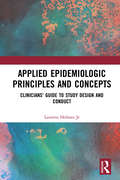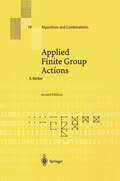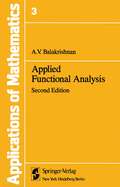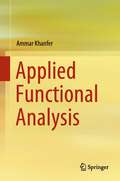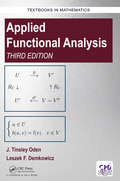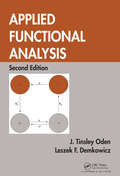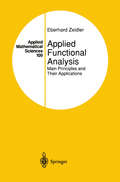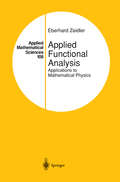- Table View
- List View
Applied Econometrics
by Stephen G. Hall Dimitrios AsteriouThis trusted textbook returns in its 4th edition with even more exercises to help consolidate understanding - and a companion website featuring additional materials, including a solutions manual for instructors. Offering a unique blend of theory and practical application, it provides ideal preparation for doing applied econometric work as it takes students from a basic level up to an advanced understanding in an intuitive, step-by-step fashion. Clear presentation of economic tests and methods of estimation is paired with practical guidance on using several types of software packages. Using real world data throughout, the authors place emphasis upon the interpretation of results, and the conclusions to be drawn from them in econometric work. This book will be essential reading for Economics undergraduate and Master’s students taking a course in applied econometrics. Its practical nature makes it ideal for modules requiring a research project.
Applied Econometrics Using the SAS System
by Vivek AjmaniThe first cutting-edge guide to using the SAS® system for the analysis of econometric data Applied Econometrics Using the SAS® System is the first book of its kind to treat the analysis of basic econometric data using SAS®, one of the most commonly used software tools among today's statisticians in business and industry. This book thoroughly examines econometric methods and discusses how data collected in economic studies can easily be analyzed using the SAS® system. In addition to addressing the computational aspects of econometric data analysis, the author provides a statistical foundation by introducing the underlying theory behind each method before delving into the related SAS® routines. The book begins with a basic introduction to econometrics and the relationship between classical regression analysis models and econometric models. Subsequent chapters balance essential concepts with SAS® tools and cover key topics such as: Regression analysis using Proc IML and Proc Reg Hypothesis testing Instrumental variables analysis, with a discussion of measurement errors, the assumptions incorporated into the analysis, and specification tests Heteroscedasticity, including GLS and FGLS estimation, group-wise heteroscedasticity, and GARCH models Panel data analysis Discrete choice models, along with coverage of binary choice models and Poisson regression Duration analysis models Assuming only a working knowledge of SAS®, this book is a one-stop reference for using the software to analyze econometric data. Additional features include complete SAS® code, Proc IML routines plus a tutorial on Proc IML, and an appendix with additional programs and data sets. Applied Econometrics Using the SAS® System serves as a relevant and valuable reference for practitioners in the fields of business, economics, and finance. In addition, most students of econometrics are taught using GAUSS and STATA, yet SAS® is the standard in the working world; therefore, this book is an ideal supplement for upper-undergraduate and graduate courses in statistics, economics, and other social sciences since it prepares readers for real-world careers.
Applied Econometrics Using the SAS System
by Vivek AjmaniThe first cutting-edge guide to using the SAS® system for the analysis of econometric data Applied Econometrics Using the SAS® System is the first book of its kind to treat the analysis of basic econometric data using SAS®, one of the most commonly used software tools among today's statisticians in business and industry. This book thoroughly examines econometric methods and discusses how data collected in economic studies can easily be analyzed using the SAS® system. In addition to addressing the computational aspects of econometric data analysis, the author provides a statistical foundation by introducing the underlying theory behind each method before delving into the related SAS® routines. The book begins with a basic introduction to econometrics and the relationship between classical regression analysis models and econometric models. Subsequent chapters balance essential concepts with SAS® tools and cover key topics such as: Regression analysis using Proc IML and Proc Reg Hypothesis testing Instrumental variables analysis, with a discussion of measurement errors, the assumptions incorporated into the analysis, and specification tests Heteroscedasticity, including GLS and FGLS estimation, group-wise heteroscedasticity, and GARCH models Panel data analysis Discrete choice models, along with coverage of binary choice models and Poisson regression Duration analysis models Assuming only a working knowledge of SAS®, this book is a one-stop reference for using the software to analyze econometric data. Additional features include complete SAS® code, Proc IML routines plus a tutorial on Proc IML, and an appendix with additional programs and data sets. Applied Econometrics Using the SAS® System serves as a relevant and valuable reference for practitioners in the fields of business, economics, and finance. In addition, most students of econometrics are taught using GAUSS and STATA, yet SAS® is the standard in the working world; therefore, this book is an ideal supplement for upper-undergraduate and graduate courses in statistics, economics, and other social sciences since it prepares readers for real-world careers.
Applied Econometrics with R (Use R!)
by Christian Kleiber Achim ZeileisR is a language and environment for data analysis and graphics. It may be considered an implementation of S, an award-winning language initially - veloped at Bell Laboratories since the late 1970s. The R project was initiated by Robert Gentleman and Ross Ihaka at the University of Auckland, New Zealand, in the early 1990s, and has been developed by an international team since mid-1997. Historically, econometricians have favored other computing environments, some of which have fallen by the wayside, and also a variety of packages with canned routines. We believe that R has great potential in econometrics, both for research and for teaching. There are at least three reasons for this: (1) R is mostly platform independent and runs on Microsoft Windows, the Mac family of operating systems, and various ?avors of Unix/Linux, and also on some more exotic platforms. (2) R is free software that can be downloaded and installed at no cost from a family of mirror sites around the globe, the Comprehensive R Archive Network (CRAN); hence students can easily install it on their own machines. (3) R is open-source software, so that the full source code is available and can be inspected to understand what it really does, learn from it, and modify and extend it. We also like to think that platform independence and the open-source philosophy make R an ideal environment for reproducible econometric research.
Applied Economic Forecasting using Time Series Methods
by Eric Ghysels Massimiliano MarcellinoEconomic forecasting is a key ingredient of decision making both in the public and in the private sector. Because economic outcomes are the result of a vast, complex, dynamic and stochastic system, forecasting is very difficult and forecast errors are unavoidable. Because forecast precision and reliability can be enhanced by the use of proper econometric models and methods, this innovative book provides an overview of both theory and applications. Undergraduate and graduate students learning basic and advanced forecasting techniques will be able to build from strong foundations, and researchers in public and private institutions will have access to the most recent tools and insights. Readers will gain from the frequent examples that enhance understanding of how to apply techniques, first by using stylized settings and then by real data applications--focusing on macroeconomic and financial topics. This is first and foremost a book aimed at applying time series methods to solve real-world forecasting problems. Applied Economic Forecasting using Time Series Methods starts with a brief review of basic regression analysis with a focus on specific regression topics relevant for forecasting, such as model specification errors, dynamic models and their predictive properties as well as forecast evaluation and combination. Several chapters cover univariate time series models, vector autoregressive models, cointegration and error correction models, and Bayesian methods for estimating vector autoregressive models. A collection of special topics chapters study Threshold and Smooth Transition Autoregressive (TAR and STAR) models, Markov switching regime models, state space models and the Kalman filter, mixed frequency data models, nowcasting, forecasting using large datasets and, finally, volatility models. There are plenty of practical applications in the book and both EViews and R code are available online at authors' website.
Applied Economic Forecasting using Time Series Methods
by Eric Ghysels Massimiliano MarcellinoEconomic forecasting is a key ingredient of decision making both in the public and in the private sector. Because economic outcomes are the result of a vast, complex, dynamic and stochastic system, forecasting is very difficult and forecast errors are unavoidable. Because forecast precision and reliability can be enhanced by the use of proper econometric models and methods, this innovative book provides an overview of both theory and applications. Undergraduate and graduate students learning basic and advanced forecasting techniques will be able to build from strong foundations, and researchers in public and private institutions will have access to the most recent tools and insights. Readers will gain from the frequent examples that enhance understanding of how to apply techniques, first by using stylized settings and then by real data applications--focusing on macroeconomic and financial topics. This is first and foremost a book aimed at applying time series methods to solve real-world forecasting problems. Applied Economic Forecasting using Time Series Methods starts with a brief review of basic regression analysis with a focus on specific regression topics relevant for forecasting, such as model specification errors, dynamic models and their predictive properties as well as forecast evaluation and combination. Several chapters cover univariate time series models, vector autoregressive models, cointegration and error correction models, and Bayesian methods for estimating vector autoregressive models. A collection of special topics chapters study Threshold and Smooth Transition Autoregressive (TAR and STAR) models, Markov switching regime models, state space models and the Kalman filter, mixed frequency data models, nowcasting, forecasting using large datasets and, finally, volatility models. There are plenty of practical applications in the book and both EViews and R code are available online at authors' website.
Applied Economics in the Digital Era: Essays in Honor of Gary Madden
by James Alleman Paul N. Rappoport Mohsen HamoudiaGary Madden was a renaissance man with respect to the nexus between information and communications technology (ICT) and economics. He contributed to a variety of fields in ICT: applied econometrics, forecasting, internet governance and policy. This series of essays, two of which were co-authored by Professor Madden prior to his untimely death, cover the range of his research interests. While the essays focus on a number of ICT issues, they are on the frontier of research in the sector. Gerard Faulhaber provides a broad overview of how we have reached the digital age and its implications. The applied econometric section brings the latest research in the area, for example Lester Taylor illustrates how own-price, cross-price and income elasticities can be calculated from survey data and translated into real income effects. The forecasting section ranges from forecasting online political participation to broadband’s impact on economic growth. The final section covers aspects of governance and regulation of the ICT sector.
Applied Engineering Mathematics
by Brian VickUndergraduate engineering students need good mathematics skills. This textbook supports this need by placing a strong emphasis on visualization and the methods and tools needed across the whole of engineering. The visual approach is emphasized, and excessive proofs and derivations are avoided. The visual images explain and teach the mathematical methods. The book’s website provides dynamic and interactive codes in Mathematica to accompany the examples for the reader to explore on their own with Mathematica or the free Computational Document Format player, and it provides access for instructors to a solutions manual. Strongly emphasizes a visual approach to engineering mathematics Written for years 2 to 4 of an engineering degree course Website offers support with dynamic and interactive Mathematica code and instructor’s solutions manual Brian Vick is an associate professor at Virginia Tech in the United States and is a longtime teacher and researcher. His style has been developed from teaching a variety of engineering and mathematical courses in the areas of heat transfer, thermodynamics, engineering design, computer programming, numerical analysis, and system dynamics at both undergraduate and graduate levels. eResource material is available for this title at www.crcpress.com/9780367432768.
Applied Engineering Mathematics
by Brian VickUndergraduate engineering students need good mathematics skills. This textbook supports this need by placing a strong emphasis on visualization and the methods and tools needed across the whole of engineering. The visual approach is emphasized, and excessive proofs and derivations are avoided. The visual images explain and teach the mathematical methods. The book’s website provides dynamic and interactive codes in Mathematica to accompany the examples for the reader to explore on their own with Mathematica or the free Computational Document Format player, and it provides access for instructors to a solutions manual. Strongly emphasizes a visual approach to engineering mathematics Written for years 2 to 4 of an engineering degree course Website offers support with dynamic and interactive Mathematica code and instructor’s solutions manual Brian Vick is an associate professor at Virginia Tech in the United States and is a longtime teacher and researcher. His style has been developed from teaching a variety of engineering and mathematical courses in the areas of heat transfer, thermodynamics, engineering design, computer programming, numerical analysis, and system dynamics at both undergraduate and graduate levels. eResource material is available for this title at www.crcpress.com/9780367432768.
Applied Engineering Statistics
by R. Russell Rhinehart Robert M. BetheaThoroughly updated throughout, this second edition will continue to be about the practicable methods of statistical applications for engineers, and as well for scientists and those in business. It remains a what-I-wish-I-had-known-when-starting-my-career compilation of techniques. Contrasting a mathematical and abstract orientation of many statistics texts, which expresses the science/math values of researchers, this book has its focus on the application to concrete examples and the interpretation of outcomes. Supporting application propriety, this book also presents the fundamental concepts, provides supporting derivation, and has frequent do and not-do notes. Key Features: Contains details of the computation for the examples. Includes new examples and exercises. Includes expanded topics supporting data analysis. The book is for upper-level undergraduate or graduate students in engineering, the hard sciences, or business programs. The intent is that the text would continue to be useful in professional life, and appropriate as a self-learning tool after graduation – whether in graduate school or in professional practice.
Applied Engineering Statistics
by R. Russell Rhinehart Robert M. BetheaThoroughly updated throughout, this second edition will continue to be about the practicable methods of statistical applications for engineers, and as well for scientists and those in business. It remains a what-I-wish-I-had-known-when-starting-my-career compilation of techniques. Contrasting a mathematical and abstract orientation of many statistics texts, which expresses the science/math values of researchers, this book has its focus on the application to concrete examples and the interpretation of outcomes. Supporting application propriety, this book also presents the fundamental concepts, provides supporting derivation, and has frequent do and not-do notes. Key Features: Contains details of the computation for the examples. Includes new examples and exercises. Includes expanded topics supporting data analysis. The book is for upper-level undergraduate or graduate students in engineering, the hard sciences, or business programs. The intent is that the text would continue to be useful in professional life, and appropriate as a self-learning tool after graduation – whether in graduate school or in professional practice.
Applied Epidemiologic Principles and Concepts: Clinicians' Guide to Study Design and Conduct
by Laurens Holmes, Jr.This book provides practical knowledge to clinicians and biomedical researchers using biological and biochemical specimen/samples in order to understand health and disease processes at cellular, clinical, and population levels. Concepts and techniques provided will help researchers design and conduct studies, then translate data from bench to clinics in attempt to improve the health of patients and populations. This book presents the extreme complexity of epidemiologic research in a concise manner that will address the issue of confounders, thus allowing for more valid inferences and yielding results that are more reliable and accurate.
Applied Epidemiologic Principles and Concepts: Clinicians' Guide to Study Design and Conduct
by Laurens Holmes, Jr.This book provides practical knowledge to clinicians and biomedical researchers using biological and biochemical specimen/samples in order to understand health and disease processes at cellular, clinical, and population levels. Concepts and techniques provided will help researchers design and conduct studies, then translate data from bench to clinics in attempt to improve the health of patients and populations. This book presents the extreme complexity of epidemiologic research in a concise manner that will address the issue of confounders, thus allowing for more valid inferences and yielding results that are more reliable and accurate.
Applied Finite Group Actions (Algorithms and Combinatorics #19)
by Adalbert KerberWritten by one of the top experts in the fields of combinatorics and representation theory, this book distinguishes itself from the existing literature by its applications-oriented point of view. The second edition is extended, placing more emphasis on applications to the constructive theory of finite structures. Recent progress in this field, in particular in design and coding theory, is described.
Applied Formal Methods - FM-Trends 98: International Workshop on Current Trends in Applied Formal Methods, Boppard, Germany, October 7-9, 1998, Proceedings (Lecture Notes in Computer Science #1641)
by Dieter Hutter Werner Stephan Paolo Traverso Markus UllmannThis volume contains the contributions presented at the International Workshop on Current Trends in Applied Formal Methods organized October 7-9, 1998, in Boppard, Germany. The main objective of the workshop was to draw a map of the key issues facing the practical application of formal methods in industry. This appears to be particularly timely with safety and security issues becoming a real obstacle to industrial software and hardware development. As a consequence, almost all major companies have now set up departments or groups to work with formal methods and many European countries face a severe labour shortage in this new field. Tony Hoare's prediction of the art of software (and hardware) development becoming a proper engineering science with its own body of tools and techniques is now becoming a reality. So the focus of this application oriented workshop was not so much on spe cial academic topics but rather on the many practical aspects of this emerging new technology: verification and validation, and tool support and integration into the software life-cycle. By evaluating the state of the art with respect to industrial applications a discussion emerged among scientists, practising engi neers, and members of regulatory and funding agencies about future needs and developments. This discussion lead to roadmaps with respect to the future of this field, to tool support, and potential application areas and promising market segments. The contributions of the participants from industry as well as from the respective national security bureaus were particularly valuable and highly appreciated.
Applied Fourier Analysis: From Signal Processing to Medical Imaging
by Tim OlsonThe first of its kind, this focused textbook serves as a self-contained resource for teaching from scratch the fundamental mathematics of Fourier analysis and illustrating some of its most current, interesting applications, including medical imaging and radar processing. Developed by the author from extensive classroom teaching experience, it provides a breadth of theory that allows students to appreciate the utility of the subject, but at as accessible a depth as possible. With myriad applications included, this book can be adapted to a one or two semester course in Fourier Analysis or serve as the basis for independent study.Applied Fourier Analysis assumes no prior knowledge of analysis from its readers, and begins by making the transition from linear algebra to functional analysis. It goes on to cover basic Fourier series and Fourier transforms before delving into applications in sampling and interpolation theory, digital communications, radar processing, medical imaging, and heat and wave equations. For all applications, ample practice exercises are given throughout, with collections of more in-depth problems built up into exploratory chapter projects. Illuminating videos are available on Springer.com and Link.Springer.com that present animated visualizations of several concepts.The content of the book itself is limited to what students will need to deal with in these fields, and avoids spending undue time studying proofs or building toward more abstract concepts. The book is perhaps best suited for courses aimed at upper division undergraduates and early graduates in mathematics, electrical engineering, mechanical engineering, computer science, physics, and other natural sciences, but in general it is a highly valuable resource for introducing a broad range of students to Fourier analysis.
Applied Fractional Calculus in Identification and Control (Studies in Infrastructure and Control)
by Utkal Mehta Kishore Bingi Sahaj SaxenaThe book investigates the fractional calculus-based approaches and their benefits to adopting in complex real-time areas. Another objective is to provide initial solutions for new areas where fractional theory has yet to verify the expertise. The book focuses on the latest scientific interest and illustrates the basic idea of general fractional calculus with MATLAB codes. This book is ideal for researchers working on fractional calculus theory both in simulation and hardware. Researchers from academia and industry working or starting research in applied fractional calculus methods will find the book most useful. The scope of this book covers most of the theoretical and practical studies on linear and nonlinear systems using fractional-order integro-differential operators.
Applied Functional Analysis (Pure and Applied Mathematics: A Wiley Series of Texts, Monographs and Tracts #47)
by Jean-Pierre AubinA novel, practical introduction to functional analysis In the twenty years since the first edition of Applied Functional Analysis was published, there has been an explosion in the number of books on functional analysis. Yet none of these offers the unique perspective of this new edition. Jean-Pierre Aubin updates his popular reference on functional analysis with new insights and recent discoveries-adding three new chapters on set-valued analysis and convex analysis, viability kernels and capture basins, and first-order partial differential equations. He presents, for the first time at an introductory level, the extension of differential calculus in the framework of both the theory of distributions and set-valued analysis, and discusses their application for studying boundary-value problems for elliptic and parabolic partial differential equations and for systems of first-order partial differential equations. To keep the presentation concise and accessible, Jean-Pierre Aubin introduces functional analysis through the simple Hilbertian structure. He seamlessly blends pure mathematics with applied areas that illustrate the theory, incorporating a broad range of examples from numerical analysis, systems theory, calculus of variations, control and optimization theory, convex and nonsmooth analysis, and more. Finally, a summary of the essential theorems as well as exercises reinforcing key concepts are provided. Applied Functional Analysis, Second Edition is an excellent and timely resource for both pure and applied mathematicians.
Applied Functional Analysis: a (Stochastic Modelling and Applied Probability #3)
by Alampallam V. BalakrishnanIn preparing the second edition, I have taken advantage of the opportunity to correct errors as well as revise the presentation in many places. New material has been included, in addition, reflecting relevant recent work. The help of many colleagues (and especially Professor J. Stoer) in ferreting out errors is gratefully acknowledged. I also owe special thanks to Professor v. Sazonov for many discussions on the white noise theory in Chapter 6. February, 1981 A. V. BALAKRISHNAN v Preface to the First Edition The title "Applied Functional Analysis" is intended to be short for "Functional analysis in a Hilbert space and certain of its applications," the applications being drawn mostly from areas variously referred to as system optimization or control systems or systems analysis. One of the signs of the times is a discernible tilt toward application in mathematics and conversely a greater level of mathematical sophistication in the application areas such as economics or system science, both spurred undoubtedly by the heightening pace of digital computer usage. This book is an entry into this twilight zone. The aspects of functional analysis treated here are rapidly becoming essential in the training at the advance graduate level of system scientists and/or mathematical economists. There are of course now available many excellent treatises on functional analysis.
Applied Functional Analysis (Textbooks in Mathematics)
by J. Tinsley Oden Leszek DemkowiczApplied Functional Analysis, Third Edition provides a solid mathematical foundation for the subject. It motivates students to study functional analysis by providing many contemporary applications and examples drawn from mechanics and science. This well-received textbook starts with a thorough introduction to modern mathematics before continuing with detailed coverage of linear algebra, Lebesque measure and integration theory, plus topology with metric spaces. The final two chapters provides readers with an in-depth look at the theory of Banach and Hilbert spaces before concluding with a brief introduction to Spectral Theory. The Third Edition is more accessible and promotes interest and motivation among students to prepare them for studying the mathematical aspects of numerical analysis and the mathematical theory of finite elements.
Applied Functional Analysis (Textbooks In Mathematics Ser.)
by J. Tinsley Oden Leszek DemkowiczThrough numerous illustrative examples and comments, Applied Functional Analysis, Second Edition demonstrates the rigor of logic and systematic, mathematical thinking. It presents the mathematical foundations that lead to classical results in functional analysis. More specifically, the text prepares students to learn the variational theory of parti
Applied Functional Analysis (Textbooks in Mathematics)
by J. Tinsley Oden Leszek DemkowiczApplied Functional Analysis, Third Edition provides a solid mathematical foundation for the subject. It motivates students to study functional analysis by providing many contemporary applications and examples drawn from mechanics and science. This well-received textbook starts with a thorough introduction to modern mathematics before continuing with detailed coverage of linear algebra, Lebesque measure and integration theory, plus topology with metric spaces. The final two chapters provides readers with an in-depth look at the theory of Banach and Hilbert spaces before concluding with a brief introduction to Spectral Theory. The Third Edition is more accessible and promotes interest and motivation among students to prepare them for studying the mathematical aspects of numerical analysis and the mathematical theory of finite elements.
Applied Functional Analysis: Main Principles and Their Applications (Applied Mathematical Sciences #109)
by Eberhard ZeidlerThe second part of an elementary textbook which combines linear functional analysis, nonlinear functional analysis, and their substantial applications. The book addresses undergraduates and beginning graduates of mathematics, physics, and engineering who want to learn how functional analysis elegantly solves mathematical problems which relate to our real world and which play an important role in the history of mathematics. The books approach is to attempt to determine the most important applications. These concern integral equations, differential equations, bifurcation theory, the moment problem, Cebysev approximation, the optimal control of rockets, game theory, symmetries and conservation laws, the quark model, and gauge theory in elementary particle physics. The presentation is self-contained and requires only that readers be familiar with some basic facts of calculus.
Applied Functional Analysis: Applications to Mathematical Physics (Applied Mathematical Sciences #108)
by Eberhard ZeidlerThe first part of a self-contained, elementary textbook, combining linear functional analysis, nonlinear functional analysis, numerical functional analysis, and their substantial applications with each other. As such, the book addresses undergraduate students and beginning graduate students of mathematics, physics, and engineering who want to learn how functional analysis elegantly solves mathematical problems which relate to our real world. Applications concern ordinary and partial differential equations, the method of finite elements, integral equations, special functions, both the Schroedinger approach and the Feynman approach to quantum physics, and quantum statistics. As a prerequisite, readers should be familiar with some basic facts of calculus. The second part has been published under the title, Applied Functional Analysis: Main Principles and Their Applications.







